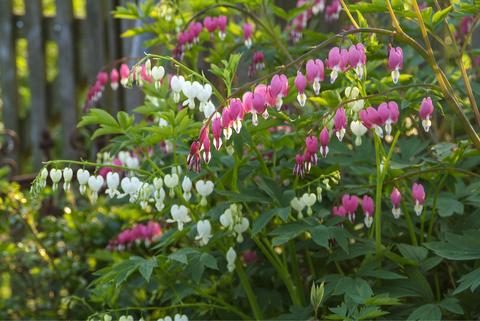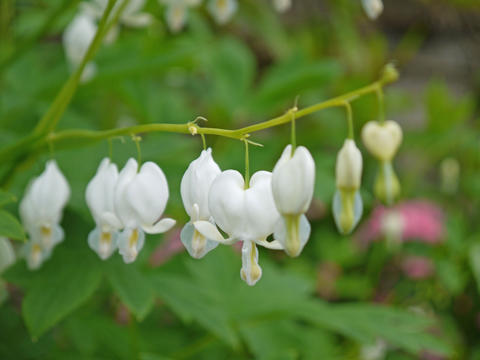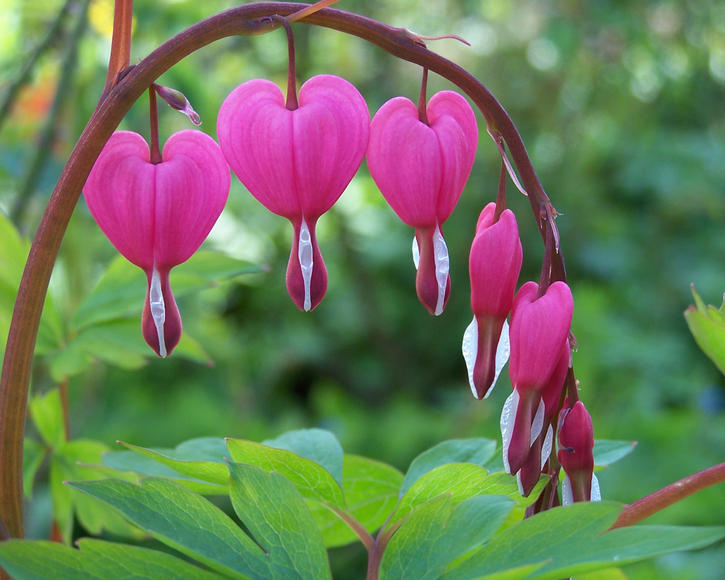Asian Bleeding Heart
So extravagant, so romantic, so low-maintenance - the Asian bleeding heart is a gorgeous, early blooming garden shrub for slight shade. Here’s how to plant and care for the bleeding heart.
Factsheet
- Growth type
-
- Perennial plant
- Growth height (from)
- from 60 cm to 80 cm
- Growth width (from)
- from 0 cm to 0 cm
- Growth characteristics
-
- overhanging
- horst-forming
- bushy
- Flower color
-
- pink
- white
- Flowering time (month)
-
- April to June
- Flower shape
-
- corymbus grapes
- Leaf color
-
- green
- page format
-
- feathered
- lobbed
- Fruit characteristics
-
- unimpressive
- Light
-
- scattered light to shady
- Soil type
-
- loamy
- Soil Moisture
-
- fresh to humid
- ph value
-
- weakly alkaline to weakly acidic
- Lime compatibility
-
- lime-tolerant
- Nutrient requirements
-
- nutrient-rich
- Humus
-
- rich in humus
- Decorative or utility value
-
- Flower Decoration
- Toxicity
-
- toxic
- Winter Hardness
-
- hardy
- Climate zones according to USDA
-
- 5
- areas of life
-
- GR2
- B2
- Use
-
- Flowerbeds
- Bouquets
- Single position
- Planters
- Underplanting
- Garden style
-
- cottage garden
- Flower garden
- Forest Garden
The Asian bleeding heart (Lamprocapnos spectabilis) naturally grows in sparse woodland in China and Korea. The plant was allocated to the bleeding hearts (Dicentra) a long time ago due to the shape of its flowers, so its old botanical name is Dientra spectabilis. In 1997, the “lady in a bath”, as this shrub is also called, was given its own genus Lamprocapnos due to its differing anatomy. Lamprocapnos spectabilis is still the only member of this genus today. This shrub is still found under its old name in retail. The Asian bleeding heart, together with other Dicentra, is part of the poppy family (Papaveraceae). In 2017, the Asian bleeding heart was chosen to be toxic plant of the year.
The Asian bleeding heart’s growth is very distinctive. This herbacous perennial grows to around 31 inches tall and up to 24 inches wide, and its flowers grow on arching stems that give it a very romantic feel.

Lamprocapnos’ fine yet dense leaves are pinnate and lobed. They grow to 16 to 7.87 inches in size. The foliage is a light, fresh shade of green. After flowering, the nutrients are absorbed and the foliage dies.
The special heart-shaped flowers are what give the Asian bleeding heart its name. They appear in spring, mostly up to a dozen per branch, and naturally vary between pink and white. Another name for this plant is “lady in a bath”. It’s easy to see why when you turn the flower over and press on it slightly.
Due to its origin in sparse woodland, the Asian bleeding heart prefers slight shade to indirect sun and a protected location, where it can be a little cooler. To properly flower, the winter-hardy Asian bleeding heart needs a frost period.
The soil should be humus-rich and moist, just like woodland soil. Lime-deficient soil and additional watering in warm summers are both recommended.

The Asian bleeding heart is planted in spring so that the roots of this perennial can establish before its first winter. Plant multiple young plants around 16 to 24 inches apart and no deeper than they were in their pots. Work a little compost into the soil around the plants. Then water well. Caution: the plant’s sap (especially in the roots) contains isoquinoline alkaloids, which can irritate skin and mucous membranes. You should therefore plant the Asian bleeding heart out of the reach of children (they are fascinated by the heart-shaped flowers) and always wear gloves to plant and prune.
To prevent the shrub from seeding, you can remove any dead heads. You should work a little compost in around the plant every two years. This is all the fertilization the Asian bleeding heart needs. On hot days, you may have to water the shrub. After establishing in early summer, the faded foliage can be cut back to the ground. Tip: if you want your Asian bleeding heart to flower a lot in spring, it’s best to house it in a frost-free greenhouse over winter.
The Asian bleeding heart can be separated as an emergency measure if it grows too large. But this shrub grows best when it can establish in one location over several years.

The Asian bleeding heart is suitable for planting at the edge of woodland and in shady gardens. Its pastel flowers look best in spring against a dark backdrop. In (semi-)shaded shrubberies, the Asian bleeding heart tends to outstretch its arched branches forwards. Caution: the Asian bleeding heart blooms in spring and fades soon afterwards. To prevent unsightly gaps in your shrubbery, you should combine this plant with some that flower in summer or fall. Good companions for the Asian bleeding heart include flowering shrubs such as hostas, coral bells (Heuchera) and Solomon’s seals (Polygonatum). White varieties look particularly harmonious with the blue flowers of the Siberian bugloss (Brunnera) and columbine (Aquilegia). The Asian bleeding heart can also showcase its attractive flowers in large containers. The branches are excellent for use as long-lasting cut flowers.
The longstanding “Alba” variety boasts pure white heart-shaped flowers. There is also a dark red and white variety named “Valentine”. It keeps its foliage for longer after flowering, fading later in the year. The “Goldheart” variety develops unusual yellow-green foliage.

The Asian bleeding heart is either propagated after flowering through separation (older plants only), through root cuttings or regular cuttings. Simply place the roughly 6-inch long cutting in water until it forms roots. The plant’s seeds may also be sown into a shrubbery. Gather the seeds in summer after the flowering period, and simply sow direct into the bed in fall. This cold germinator uses the winter months to activate germination. In a cottage garden, seed sowing can simply be left to the plant.
If the Asian bleeding heart gets too dry, it may dry out and fall foul to lice. Slugs and snails love the delicate foliage in spring, so you should begin defence measures as soon as the plant becomes active. If the site is too humid (waterlogged) and warm, the watering heart easily gets powdery mildew or stem base rot (phytophtora). Holes in the tips of flowers do not come from a pest, but are bitten into by earth bumblebees, which in this way get to the nectar.

